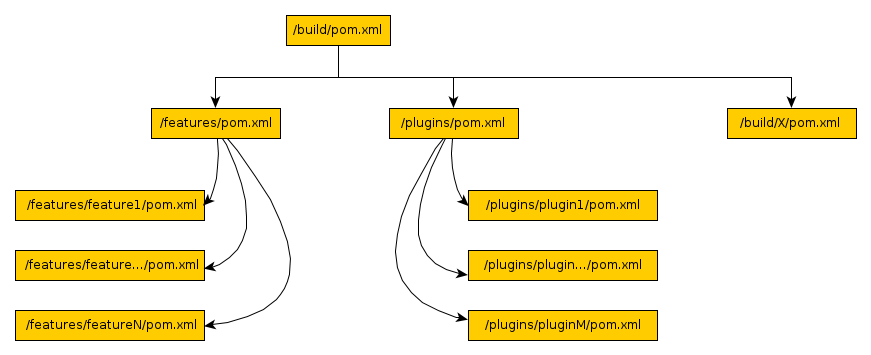Page History
...
The Automatic Build Process
Maven and Tycho in KIELER
In KIELER there is a parent POM located in build/de.cau.cs.kieler.parent, there are mid-level POMs in features and plugins and finally each plugin and feature directory contains a POM file. Furthermore to handle building an Eclipse P2 repository and the KIELER RCA there is a special repository project with its own POM in build/de.cau.cs.kieler.repository. As KIELER is This section describes how our POM files are distributed throughout the repository structure, and how you can trigger an automatic build of KIELER.
POM Files
The basic structure of the POM files can be seen below:
Each plug-in and feature has a corresponding (usually rather small) POM file. The POM files in the features and plugins directories know about the different features and plug-ins. The parent POM file, which all other POM files copy basic configuration from, knows about the feature and plug-in POM files. In addition, the build directory also contains a bunch of subdirectories. These also contain POM files specialized for building the P2 repositories necessary to publish our Eclipse features.
Using the KIELER Maven Build
Using the KIELER Maven build requires knowledge about two aspects: necessary configuration / required libraries and invoking Maven.
Necessary Configuration
KIELER needs to be built against a P2 repository generated from our Eclipse reference installation. The path to this repository is found in the parent POM file and must be changed if the repository location changes. Also, the following magic command updates the P2 build repository after changes to the installation.
...
when changing the reference installation, the repository has to be updated using the following magic command (adapted accordingly):
| Code Block | ||
|---|---|---|
| ||
java -jar eclipse_3.8/plugins/org.eclipse.equinox.launcher_*.jar \
-application org.eclipse.equinox.p2.publisher.FeaturesAndBundlesPublisher \
-metadataRepository file:/home/java/repository/juno382 \
-artifactRepository file:/home/java/repository/juno382 \
-source /home/java/eclipse_3.8/ \
-publishArtifacts
|
Things to be aware of
| Warning |
|---|
|
Building Kieler on the command line
A full KIELER build on the command line is done as follows
| Code Block | |
|---|---|
| language | bash |
| title | Full Build | linenumbers | true
Invoking Maven
To actually build KIELER once all preliminaries are done, navigate to the /build/de.cau.cs.kieler.parent directory and run the following command line:
| Code Block | ||
|---|---|---|
| ||
mvn clean package -P <profile> # For a list of available profiles, see parent pom.xml |
If you are trying to build KIELER on our server, you first have to setup the Java environment, if you haven't already done so. The command line thus becomes:
| Code Block | ||
|---|---|---|
| ||
. /home/java/java-env #sets environment variables for java and maven cd build/de.cau.cs.kieler.parent mvn clean package -P <profile> # For a Availablelist profilesof includeavailable indigoprofiles, see juno38, juno42 |
...
parent pom.xml |
Once Maven has finished, the different build artifacts may be found in the /build/de.cau.cs.kieler.*.repository/target. Similarly single plugins or features are found in the target subdirectory of the respective package directories.
What to Be Aware of
There are some things that people need to be aware of to keep the build files in a valid state.
- Eclipse metadata and POM files are not synchronized. Thus, if the version of an Eclipse plug-in changes, its
pom.xmlneeds to be updated accordingly. - The repository POM directories contain product files and product icons. These are copies of the files found in the corresponding branding plug-ing (such as
de.cau.cs.kieler.core.product) and have to be manually synchronized.
Continuous and Nightly Builds
...
